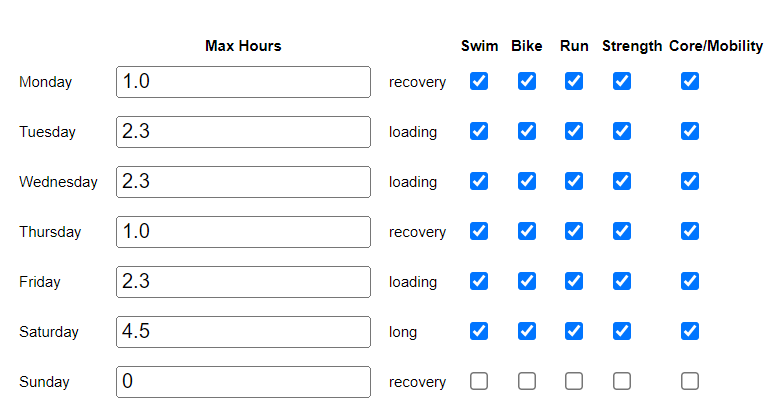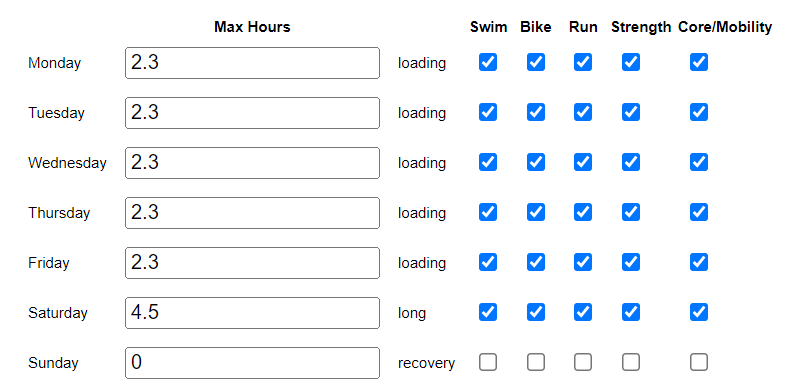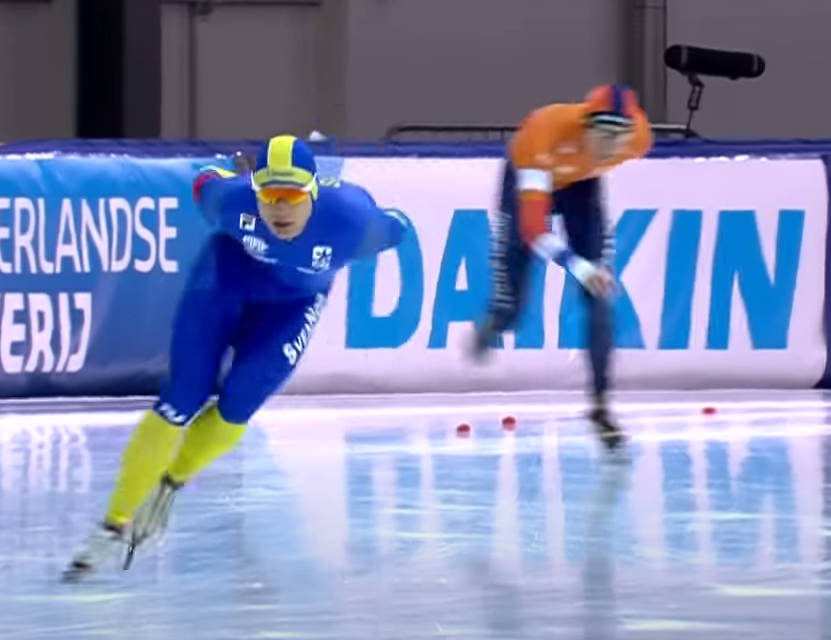Guidelines for setting up your training week: Lessons from Nils
Alan Couzens, M.Sc.(Sports Science)
One of the biggest stories from the recent Winter Olympics has to be the success of Swedish speedskater Nils van der Poel. Specifically, breaking his own 10,000m World Record with a time of 12:30.74 - more than two seconds under the previous mark! Amazing as the performance was, the real thing that set this performance aside from so many others was that he outlined, in painstaking detail, just how he accomplished this amazing feat in his 60 page training manifesto - How to Skate a 10K. There are so many gems in that booklet that I am sure I will keep coming back to, but one of the most significant was how Nils set up his training week.
One of the most important tasks for an athlete is coming up with a realistic, sustainable training week. I learned from former Pro triathlete, Gordo Byrn just how powerful setting up a regular, repeatable "basic week" can be. The emphasis that Nils placed on his weekly pattern was a good reminder of this.
For Nils, one of the key factors in his success was adhering to a regular weekly loading-recovery pattern of 5 days on, 2 days off. In his own words...
"I almost always trained after a 5-2 day training program. Training for five days and then resting for two days. My rest days were usually during weekends. In that way I could spend the weekends doing fun stuff with my friends. Usually I did not train at all during rest days. I rested both my mind and my body. However, if my friends wanted to go alpine skiing or go for a hike, I would join them. But I didn’t perform any intended active recovery. I tried to live a normal life."
The striking thing about the quote above is the emphasis that Nils' places on his 2 *true* recovery days each week. In my experience, it's very common for athletes to play lip service to "recovery days", which really only amount to a slight reduction in the training load. Nils, OTOH, takes his recovery very seriously and includes 2 days every week where he really shut it down and made the sole focus recovery for the next cycle.
Clearly, Nils placed a high priority on the separation of his "loading" and "recovery" days, with his loading days amounting to 5-7 hours and his recovery days close to zero! Let's start by putting these in "mere mortal" terms :) so that we can better define the different types of training days in your week. In my way of thinking, there are 3 basic categories of training days...
Loading Days: are your standard "bread and butter" training days that add fitness. The specific type of fitness that they add - aerobic, strength, muscular endurance, threshold, VO2, speed will vary with the different phases but the common thread is that these days are designed to tax you a little above what is currently "normal" for you & thus, are designed to add a little fatigue to the system. In training load terms, these days will typically be about 30-60 TSS above your current CTL.
Recovery Days: If we are going to have some days that make you more tired, we will need to balance those out with some days that have a focus on recovery, i.e. getting you back to baseline. Depending on the level of the athlete this could mean a pure rest day, it could mean pure active recovery or very easy aerobic work at a lower volume/load. In training load terms, these days will be at least 30TSS below your current CTL
BIG days: One of the most important adaptations that we're seeking, especially in the base phase is improvements in the athlete's fat burning base. To obtain these adaptations, some of the sessions will have a pure duration focus. These are the highest training load days and will typically demand a recovery day after each. In training load terms, these can be 2x your regular loading day.
Translating these training load targets to workout duration, I offer the following recommendations for each of the different workout types for each level of Chronic Training Load (CTL)
| Category | CTL | Recovery Day | Loading Day | BIG Day |
|---|---|---|---|---|
| Health & Fitness | 0 - 45 | 0 - 1 hrs | 1.2 - 2.2 hrs | 2 - 3.5 hrs |
| Recreational | 45 - 75 | 0 - 1 hrs | 1.8 - 2.3 hrs | 2.2 - 4.5 hrs |
| Developmental | 75 - 105 | 0 - 1 hrs | 2.4 - 3 hrs | 3 - 5.2 hrs |
| Competitive | 105 - 135 | 0 - 1.5 hrs | 3 - 3.8 hrs | 4 - 6.2 hrs |
| Top Amateur | 135 + | 0 - 3 hrs | 3.5 - 3.8 hrs | 4.4 - 9.0 hrs |
You will notice that, following Nils' lead, I advocate quite a separation in training duration between your "loading days" and your "recovery days". This is quite deliberate & follows along with the Golden rule to 'keep your hard days hard and your easy days easy'. Physiologically, there is benefit to minimizing monotony in training. Again, in the words of Nils:
"But the upside to the 5-2 in the long run was not only psychological. As I rested for two days my body would get a reset."
As Nils suggests, one of the most important features of any successful training plan is period of stress followed by periods of rest. That is, periods where the load is significantly greater than your average followed by a period of dedicated recovery where the load is significantly lower . This is true, to an extent, irrespective of the intensity - i.e. productive workouts, even productive threshold or VO2max workouts, take a significant amount of time to complete. I sometimes see athletes with no clear separation between loading and recovery days - just grinding along at about the same load each day & trying to squeeze in as much intensity as time will allow. This is the wrong approach. If you are going to do a key "Breakthrough" workout, you want to save it for a day that you have sufficient time to challenge your body appropriately, followed by a period where you allow your body to recover appropriately
Additionally, in order to progress your fitness, it should come as no surprise that, within these loading-recovery periods, over the long term, you are going to need more loading days than recovery days! In the case of someone targeting an Olympic Gold,, this might be in the ratio of 5:2! However, for the average athlete...
...a basic guideline that I recommend is to allot a maximum of 3 recovery days per week allowing for at least 4 loading/big days.
This 4/3 or 5/2 or 6/1 pattern makes for a loading week, i.e. a week where more sessions fall above the athlete's current average load than fall below it. It's out goal forthis to happen on the majority of weeks to ensure long term progressThe above isn't to say that every week will follow a 4-3 or 5-2 pattern. Some weeks the athlete may require more recovery & the loading/recovery ratio may be 3/4 or 2/5 or even 1/6. This is completely expected, appropriate and necessary! The important thing, just like the loading days, is for there to be more loading weeks than recovery weeks over the long term &, for this to happen, it is important to create sufficient space in your standard week for the loading weeks to be able to take place when appropriate.
Combining these "rules of thumb" with the table above, a 'fixed' week set-up for an athlete with a CTL of ~70 TSS/d may look something like
Recovery
1 hr
(40TSS)
Load
2hrs
(100TSS)
Load
2 hrs
(100TSS)
Recovery
1 hr
(40TSS)
Load
2 hrs
(100TSS)
BIG
4 hrs
(200TSS)
Rest
(0TSS)
Per our rules of thumb, we have 3 loading days, 1 big day and 2 recovery days. The loading days are 30TSS/d above the athlete's current CTL (70+30=100), the BIG day is twice this & the remaining days are either pure rest or an hour of active recovery work. This would be a solid "standard" week for an athlete with a CTL of ~70. If you're using my Personalized Training Plans you could set up your week (in line with the recommendations in the table above for a 70CTL athlete) by going to your weekly availability page and setting it up as follows...

If you do this, the workouts in your TrainingPeaks account for the following week & every week thereafter (until you edit your week again) will stick to the constraints/pattern above
This might represent a pretty typical working athlete weekly schedule where they want to leave one day each week completely allocated as a "Family Day" and a couple of days through the work week where training is scaled back and work(&/or a sleep in! :-) is the priority. e.g a sample week in the Base period with the above constraints....
| am | pm | |
|---|---|---|
| Monday (Recovery) | Off (Sleep In) | Technique Swim (1.0) |
| Tuesday (Loading) | Easy Run (0.5) | Speed Bike - Trainer (1.5) |
| Wednesday (Loading) | Easy Run (0.5) | Aerobic Run (1.5) |
| Thursday (Recovery) | Off (Sleep In) | Easy Bike - Small Ring Spin (1.0) |
| Friday (Loading) | Easy Run (0.5) | Speed Swim (1.0) |
| Saturday (BIG) | Long Bike + T-Run (4.0) | Off (Family) |
| Sunday (Recovery) | Off (Sleep In) | Off (Family) |
Very importantly, these represent maximal hours available for that day. This doesn't mean that we want to fill these hours every week! As I said above, not every week will be the 4/3 load/recovery week that you've allotted space for. If, for example, the athlete has a stressful weekend that leaves them short on sleep & they rock up to Tuesday with still below average freshness, even though we have 2 hours available, we'll listen to the body and use that extra time for some extra recovery - a sleep in etc. To see this principle in action, you can select the low freshness condition on the drop down and see how the week changes to a 3/4 recovery week. Sometimes the most beneficial part of carving out the training hours in your basic week is in not using them for training but instead using this free time for some much needed recovery!
Another striking quote from Nils...
."Thanks to consecutive use of the 5-2 model I knew how tired I could be, how sadly my pulse could respond, how low my lactate response could be and how much my watt numbers on the bike could drop on a Wednesday session, but still make me able to make it to Friday in a decent manner. In short: the 5-2 made it very easy to manage the training load"
For a World Class athlete, life is built around training & so, the physiology can be calibrated to changes in the training load - as Nils beautifully outlines above. There is a constancy of life that facilitates the physiology falling into these predictable wave like patterns. This is much less likely to be the case for the typical amateur athlete....
While scheduling recovery days within your week is a big step up from not scheduling recovery, an even better approach, especially for the amateur athlete, is to take recovery when your body needs it! Steve Magness points out the merits of this flexible "free pass" approach here...
Those whose goal is to work out 7 days a week, but they have two "free passes" to use to a skip a workout every week do much better than those whose goal is to workout either 7 days or 5 days a week.
— Steve Magness (@stevemagness) January 1, 2022
The out allows them to stay in it without spiraling. https://t.co/HP1OSRwYVo
In this case, rather than saying Monday & Thursday are always going to be recovery days, an even better approach, if your schedule allows, is for our 70 CTL athlete to set their weekly availability to the max of the standard 2.3 hours each day & then to use those "free passes" when their body needs it! (as shown below)
 E.g. if we don't designate Monday as a 1 hour recovery day, but instead adopt a 'wait and see' approach, Monday could be a recovery day OR we might find that we come into the week feeling really great and, since we have the time carved out, we're able to keep the loading days rolling through the early week & we manage 4 loading days and a big day this week, i.e. a 5/2 "SUPER loading" week :) that gives our fitness a 'turbo boost' above the usual ramp rate. You can change the dropdown to see how this approach might look for the "high freshness" week.
E.g. if we don't designate Monday as a 1 hour recovery day, but instead adopt a 'wait and see' approach, Monday could be a recovery day OR we might find that we come into the week feeling really great and, since we have the time carved out, we're able to keep the loading days rolling through the early week & we manage 4 loading days and a big day this week, i.e. a 5/2 "SUPER loading" week :) that gives our fitness a 'turbo boost' above the usual ramp rate. You can change the dropdown to see how this approach might look for the "high freshness" week.
############
My 'take home' points when it comes to setting up your training week...
* In order to make long term progress we only need to keep a general trend towards a little more load than recovery. This is true at the week level, the block level & the year level.
* While a rigid weekly schedule that tells us when our body is going to be doing hard work tends to appeal to our brain, it makes a lot more sense to keep a flexible approach & check in with our body!
* Carving out regular, non-negotiable, weekly slots that are devoted to our athletic development creates space in our lives that can offer significant benefit to our health, fitness and performance, even when we don't use those slots for training!
Train smart,
AC

